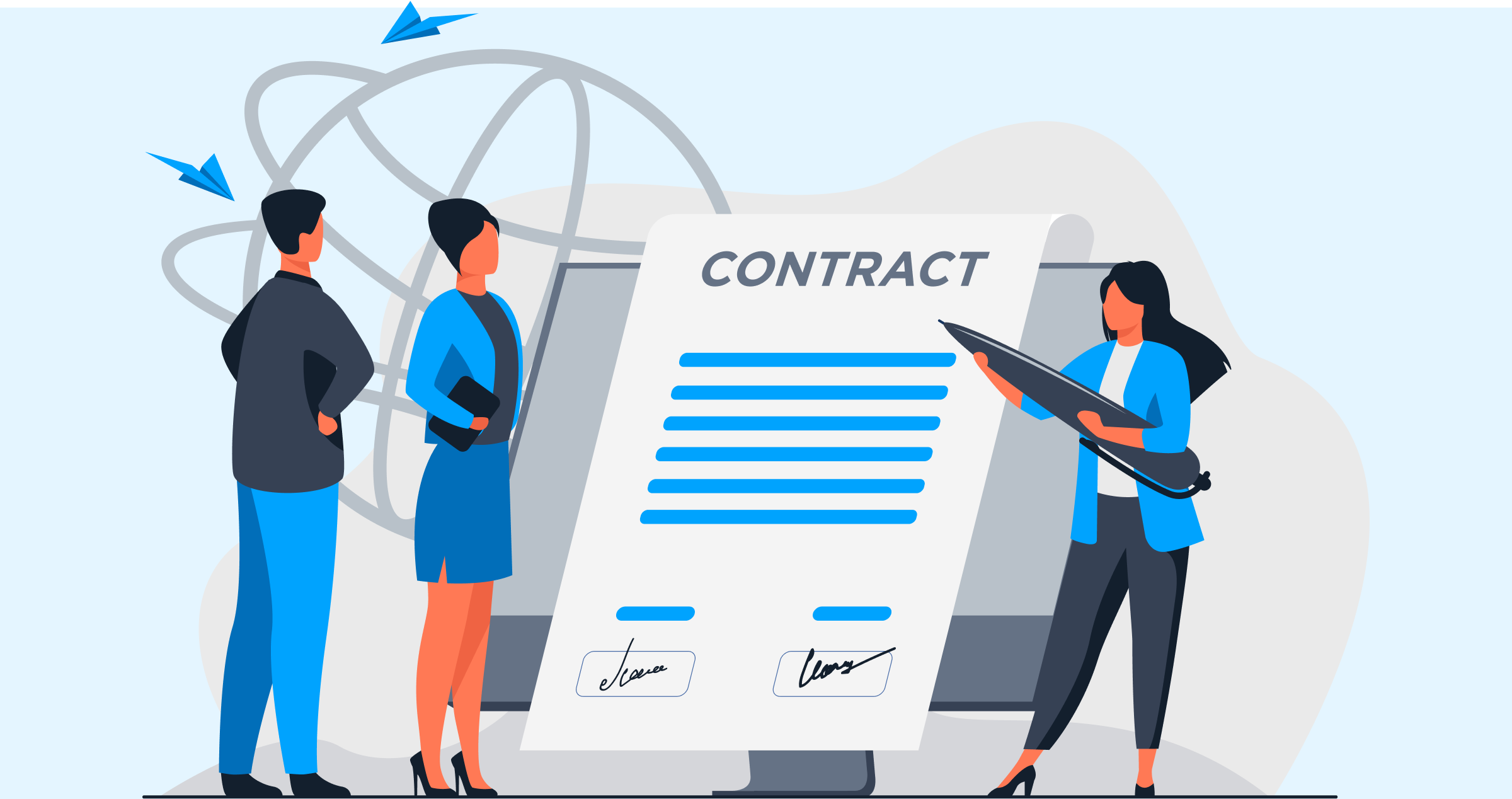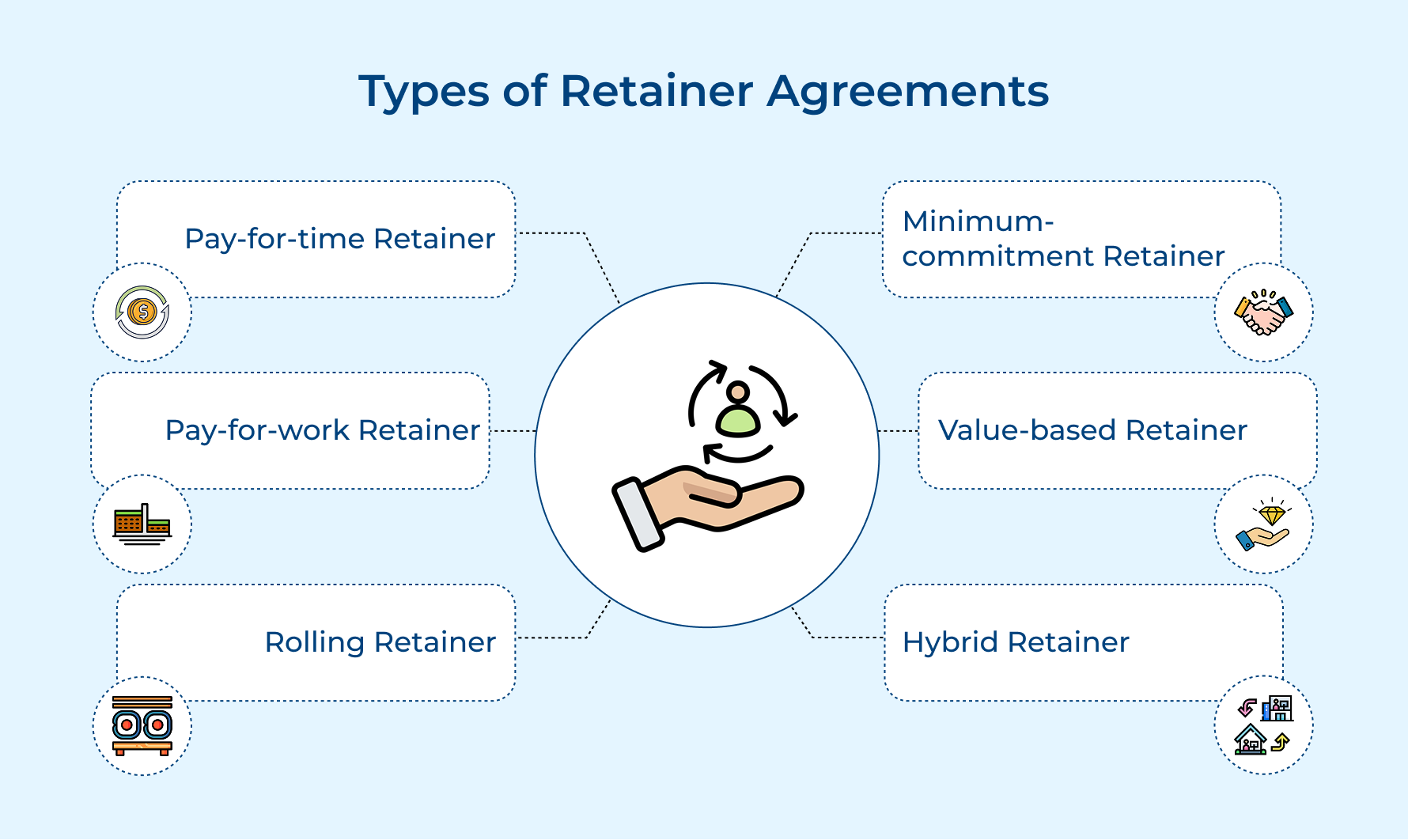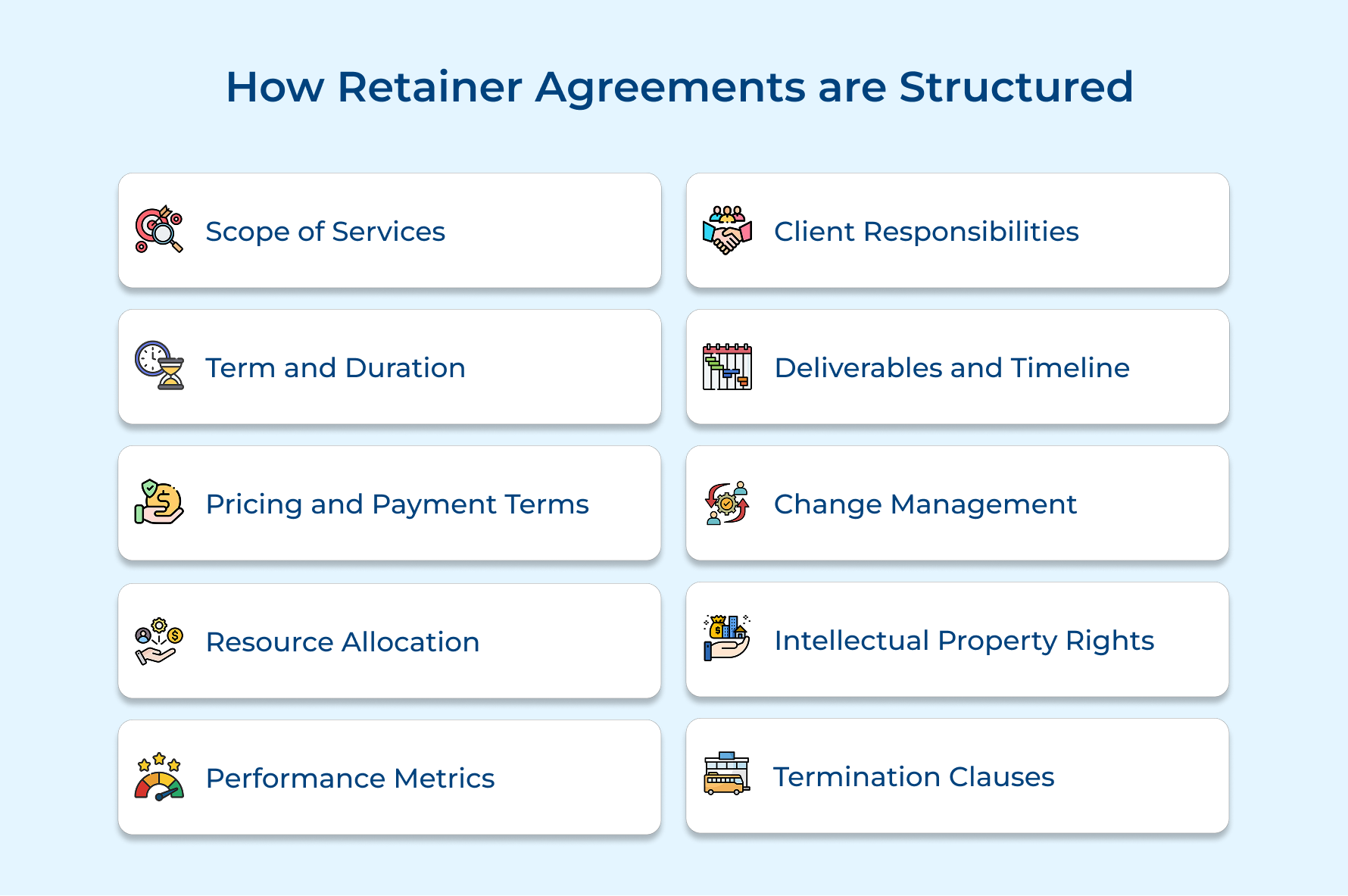What is a Retainer Agreement? Types, Benefits & Structure

Key Highlights:
- Discover various retainer agreement models like pay-for-time, value-based and hybrid, tailored to different business dynamics.
- Retainers ensure predictable income and operational stability while offering priority access for clients.
- Explore industry-specific retainer applications, from marketing content packages to IT support, showcasing their role in building stable partnerships.
Managing client relationships can be tricky, especially with unpredictable cash flow, fluctuating demands, and constant contract renegotiations adding stress. That’s where a retainer agreement can save the day!
It provides a win-win solution by ensuring steady income for service providers while giving clients reliable access to essential services. With this arrangement, both sides enjoy stability, commitment, and clarity. Think of it as locking in a long-term partnership that eliminates the uncertainty of project-based work.
So, let’s dive into the perks of retainer agreements and share tips to avoid common pitfalls for smooth, successful collaborations.
What is a Retainer Agreement?
A retainer agreement definition is a formal contract between a professional services firm and a client that establishes an ongoing business relationship with predefined terms, scope, as well as payment structure.
Unlike project-based contracts, retainer agreements secure a specified amount of the service provider’s time, resources, or deliverables for an extended period in exchange for regular payments.
These agreements are particularly valuable in industries where ongoing expertise or services are needed, such as legal services, marketing agencies, PR firms, IT consultancies, etc. They help establish clear expectations and deliverables while providing a framework for managing scope changes along with additional requests.
Key Objectives
- Clear expectations: Establishes a mutual understanding of the scope, timing, and services provided, reducing misunderstandings.
- Financial stability: Provides service providers with guaranteed payment, ensuring they have a consistent income stream.
- Priority access: Ensures that clients have dedicated availability from the service provider as needed, especially during peak times.
- Long-term relationships: Encourages ongoing collaboration, building a stronger working relationship between the client and provider.
Types of Retainer Agreements
Not all retainers are created equal! From time-based retainers to deliverables-focused contracts, there’s a variety of business retainer agreements. Let’s explore them each:
1. Pay-for-time retainer is where the client reserves a specific number of hours or days per month from the agency’s team. The fee remains constant regardless of actual usage, ensuring resource availability when needed. This model works well for ongoing consulting or advisory services.
Example: A marketing agency reserves 40 hours monthly for a client’s ad-hoc creative requests, brand consultation, and strategic guidance.
2. Pay-for-work retainer agreement specifies fixed deliverables or outputs provided monthly. The agency commits to delivering predetermined services or results, regardless of time spent. Pricing reflects the value of deliverables rather than hours.
For instance, an agency commits to delivering four blog posts, two newsletters, and one whitepaper monthly for a fixed fee.
3. Rolling retainer unused hours or budget rollover to subsequent periods within agreed limits. This flexible model accommodates varying workloads while maintaining consistent billing. Clients appreciate the flexibility of bank hours.
For instance, the client’s unused 10 hours from March roll over to April, allowing for larger projects or increased support when needed.
4. Minimum-commitment retainer sets a base monthly fee for core services with the flexibility to scale up as needed. Additional work beyond the minimum commitment is billed separately at predetermined rates.
Example: Social media management baseline package with additional content creation billed separately based on client requests.
5. Value-based retainer pricing based on delivered value/outcomes rather than time or specific deliverables. Often includes performance metrics or success indicators that influence the fee structure.
For instance, a PR agency’s retainer includes success bonuses for achieving specific media placement targets or audience reach metrics.
6. Hybrid retainer combines multiple retainer types to create customized arrangements. May include fixed deliverables plus reserved hours for additional support, providing both structure and flexibility.
Example: Monthly website maintenance package plus 10 hours of on-call development support for urgent updates.
How Retainer Agreements are Structured
A well-structured retainer agreement lays the foundation for a smooth collaboration. Let’s break down the key elements that ensure clarity and alignment for both parties.
1. Scope of Services
A clear scope of work outlines exactly what services and deliverables are included, setting clear boundaries while also managing expectations from the start.
The transparency prevents misunderstandings as well as scope creep, ensuring both the agency and client are aligned on what’s covered. It’s a win-win—avoiding disputes, strengthening relationships, and making resource planning a breeze.
Stay organized by creating a service matrix that lists included services, their frequency, and specific deliverables. It can double as a handy reference for tracking progress and managing client expectations. Regularly reviewing the scope keeps things aligned with your client’s evolving needs.
Actionable Tips:
- Build a detailed service catalog that lists what’s included (as well as excluded), using simple language and examples.
- Set up a process for handling out-of-scope requests, complete with decision trees and approval workflows.
2. Term and Duration
General retainer agreement needs a clear timeline that spells out the start and end dates, renewal terms, as well as termination provisions. It ensures both parties know the commitment length and exit procedures, offering stability along with better resource planning.
A well-structured agreement might include initial terms, automatic renewals, and defined notice periods for changes or cancellations.
Tips to consider:
- Specify dates for reviews, renewals, and required notice periods.
- Use a contract monitoring system with automated alerts to stay on top of key deadlines and renewal dates.
3. Pricing and Payment Terms
A transparent breakdown of retainer fees and financial terms is key to maintaining a smooth business relationship. Here’s how to keep things clear and stress-free:
- Fee structure: Outline retainer fees, payment schedules, and rates for additional services upfront.
- Expense policies: Specify how expenses and overages will be handled to avoid surprises.
- Tiered pricing: Offer pricing tiers with defined deliverables at each level, so clients know what they’re getting.
- Payment clarity: Include detailed payment schedules and billing policies for transparency.
Pro Tips:
- Use standardized rate cards for extra services with a clear approval process.
- Set up automated billing with consistent invoicing and payment tracking.
4. Resource Allocation
Clearly defining team members and their roles is crucial for a successful retainer agreement. Ensure smooth resource allocation by,
- Team roles: Specify which team members are involved, their roles, and their availability.
- Continuity plans: Include backup arrangements to maintain service quality and continuity.
- Scalability: Outline procedures for managing resource changes or adding team members as needed.
Actionable Tips:
- Keep resource calendars updated and use a notification system for team changes.
- Develop clear handover procedures with proper documentation to ensure seamless transitions during resource shifts.
5. Performance Metrics
Measurable indicators and KPIs are essential for tracking the success of a retainer agreement. How to set them up effectively?
- Define KPIs: Identify clear metrics to measure service quality, value delivery, and overall effectiveness.
- Monthly dashboards: Create reports showing key metrics, trends, as well as achievements to highlight progress.
- Regular reviews: Schedule meetings to discuss performance, share insights, and explore improvement opportunities.
Actionable Tips:
- Use automated tools for tracking KPIs with easy-to-read visualizations.
- Standardize review meeting agendas and include actionable plans for optimization.
6. Client Responsibilities
Defining client responsibilities is key to smooth and successful service delivery. Set the stage for collaboration with the following steps,
- Client Inputs: Clearly outline what inputs, approvals, and access the client needs to provide.
- Accountability: Set realistic expectations for client involvement to avoid delays and maintain quality.
- Communication: Use clear channels for updates and response timelines to keep everything on track.
Tips to consider:
- Create a client onboarding guide that explains timelines and responsibilities for each project phase.
- Use automated reminders to ensure timely inputs and approvals from the client.
7. Deliverables and Timeline
When both parties are on the same page about what’s expected and when it prevents misunderstandings as well as keeps the workflow smooth. This clarity also provides a framework for tracking progress, ensuring consistency, and making resource planning more effective.
Stay organized by creating detailed delivery schedules with specific milestones and deadlines. Pair these with quality checklists and review processes to ensure every deliverable meets expectations.
Regularly reviewing timelines with the client helps maintain alignment and adapt to changing needs.
Pro Tip: Standardized templates and quality checklists can streamline the creation of deliverables, while project management tools with automated tracking and milestone alerts keep everything on schedule.
8. Change Management
Handling changes to a retainer agreement requires clear procedures to keep things organized and fair. Having a structured process ensures transparency as well as avoids misunderstandings.
Start by implementing a clear change request process. Use simple forms to document what’s changing as well as assess the impact on resources, timelines, and costs.
Approval workflows make sure everyone is on the same page before changes are implemented. Regular scope reviews can also help identify and address necessary adjustments early on.
Pro Tip: Consider setting up a change advisory board to review and approve significant modifications. It adds an extra layer of accountability and helps maintain balance in the working relationship.
9. Intellectual Property Rights
Legal framework defining ownership and usage rights for work produced under the retainer, including confidentiality terms as well as data handling requirements.
Clear IP rights protect both parties’ interests and prevent future disputes over work ownership. It ensures proper handling of sensitive information as well as maintains professional standards.
Include detailed IP clauses in agreements. Create clear processes for transferring rights and handling confidential information.
Actionable Tips:
- Develop clear guidelines for marking and handling confidential information with specific security protocols.
- Create standardized IP transfer documentation for deliverables with clear ownership statements.
10. Termination Clauses
Ending a retainer relationship can be tricky, but clear procedures make the process smooth and professional. How to handle it effectively?
- Notice periods: Define specific notice periods to give both parties enough time to plan the transition.
- Transition plans: Prepare detailed plans for service handover, ensuring continuity for the client.
- Final settlements: Include clear procedures for wrapping up payments, deliverables, and unresolved tasks.
- Regular reviews: Use periodic relationship reviews to identify when termination might be necessary.
Actionable Tips:
- Develop an exit checklist that covers all aspects of the transition and handover process.
- Use templates for termination notices and final settlement documentation to keep things
Benefits of Retainer Agreement
Retainer agreements offer more than just stability—they ensure predictable income for service providers. Let’s explore the benefits of retainer agreement and how they simplify workflows.
For Agencies/Service Providers
1. Predictable Revenue
Retainer agreements provide a steady, guaranteed monthly income, making financial planning and cash flow management much easier. This stability supports strategic investments, smarter hiring decisions, and long-term growth while reducing the uncertainty of fluctuating revenue.
2. Efficient Resource Planning
With consistent work on the table, agencies can allocate their teams more effectively, plan capacity better, and maintain stable utilization rates. The long-term visibility helps with strategic staffing and eliminates the chaos of juggling resources for one-off projects.
3. Operational Stability
Regular workflows and established processes streamline operations as well as reduce administrative headaches. Consistent work patterns enable standardized delivery methods, refined processes, and smoother project management overall.
For Clients
1. Priority Access
With a retainer agreement, clients enjoy guaranteed access to dedicated resources and priority response times. It also translates to faster resolutions, consistent support, and reliable expertise when they need it most.
2. Cost-Effectiveness
A fixed monthly fee often delivers better value compared to project-based billing. Clients can plan budgets more predictably, enjoy economies of scale, and often benefit from preferential rates for extra services.
3. Simplified Management
Established workflows and processes minimize administrative effort as well as make vendor management a breeze. Regular reports and clear communication ensure smooth oversight of service delivery.
Mutual Benefits
1. Quality Improvement
Consistent engagement allows both parties to refine processes, improve deliverables, and achieve better outcomes over time. Feedback loops and regular performance reviews lead to continuous optimization along with higher quality standards.
2. Growth Opportunities
Long-term partnerships build innovation, mutual growth, and market expansion. By investing in the relationship, both parties can unlock new opportunities and build capabilities together.
Real-World Examples of Retainer Agreements
Retainer agreements are widely used across industries to build long-term, stable partnerships. Let’s look at some real-world examples to see how they work in practice.
Marketing Agency Examples
1. Social Media Management Agency provides comprehensive social media oversight including daily content creation, community engagement, and crisis management. The package ensures consistent brand presence across platforms while delivering monthly analytics and strategy adjustments.
2. Content Marketing Package Retainer delivers consistent content flow with SEO-optimized blog posts, newsletters, and quarterly whitepapers. The team manages content strategy, creation, and distribution while ensuring brand voice consistency along with engagement metrics.
IT Services Examples
1. Technical Support Round-the-clock technical assistance with dedicated helpdesk access. The package includes proactive system monitoring, regular security updates, and issue resolution within agreed SLA timeframes across all technology platforms.
2. Website Maintenance Ensures website performance and security through regular updates, monitoring, as well as content management. Includes weekly security patches, performance optimization, and dedicated hours for content updates as well as SEO maintenance.
Legal Services Examples
1. Business Advisory Provides ongoing legal guidance with allocated consultation hours, routine contract reviews, and compliance monitoring. Includes proactive risk assessment and regular updates on relevant legal changes affecting business.
2. Full Legal Coverage Comprehensive legal protection with unlimited consultation and complete contract management. Covers all aspects of business legal needs, including compliance, litigation support, and regulatory filing assistance.
Consulting Examples
1. Business Strategy Strategic partnership providing regular business analysis, market insights, and performance monitoring. Includes monthly strategy sessions along with quarterly reviews to ensure business objectives alignment.
2. Operations Consulting Focused on operational excellence through continuous process optimization and performance monitoring. Delivers regular efficiency recommendations, team performance reviews, and change management guidance for implementation.
Building Long-Term Success with Retainer Agreements
Retainer agreements offer significant advantages for both service providers and clients, creating a foundation of stability. Service providers benefit from a steady income stream, making it easier to plan resources and manage workloads, while clients enjoy consistent, prioritized support over time.
Clearly defined terms and expectations are key to ensuring smooth collaboration. When both parties understand the scope of work, payment terms, and communication guidelines, misunderstandings are minimized, ensuring the relationship becomes more productive.
A well-structured retainer agreement builds trust and enables long-term success. With these agreements in place, both businesses and clients can build stronger, more fruitful partnerships.
Limit time — not creativity
Everything you need for customer support, marketing & sales.
Neeti Singh is a passionate content writer at Kooper, where he transforms complex concepts into clear, engaging and actionable content. With a keen eye for detail and a love for technology, Tushar Joshi crafts blog posts, guides and articles that help readers navigate the fast-evolving world of software solutions.


